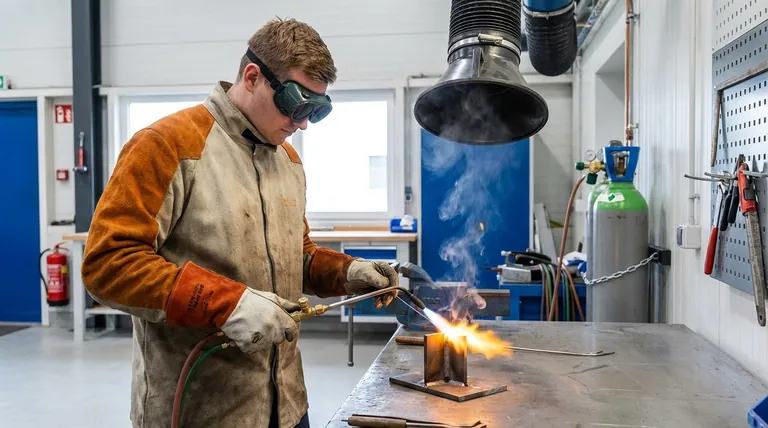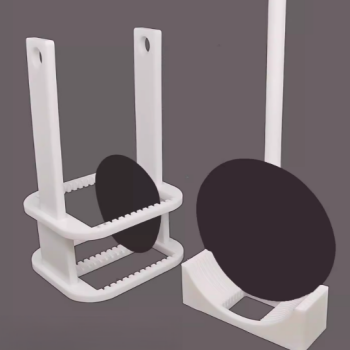To braze safely, you must implement a system of precautions that addresses the primary hazards of the process: intense heat, harmful fumes, and potential fire. This involves using the correct personal protective equipment (PPE), ensuring adequate ventilation to remove airborne contaminants, and maintaining a well-prepared, fire-safe workspace.
The core principle of brazing safety is layered defense. No single precaution is sufficient; you must combine personal protection, environmental controls, and safe work practices to mitigate the inherent risks of high temperatures and chemical reactions.

Foundational Safety: Personal and Environmental Protection
Your first priority is to create a safe environment for yourself and the workspace. This involves protecting your body from immediate harm and ensuring the air you breathe is clean.
Proper Personal Protective Equipment (PPE)
Your PPE is the first line of defense against heat, infrared radiation, and spatter.
Always wear safety glasses or goggles with appropriate shading (typically shade 3-5 for brazing) to protect your eyes from the bright flame and harmful radiation.
Use flame-retardant clothing, such as a leather apron or welding jacket, to protect your skin and clothes from heat and sparks. Cotton or wool is preferable to synthetic fabrics, which can melt and cause severe burns.
Wear dry, insulated gloves, like leather welding gloves, to handle hot materials and protect your hands from the torch flame.
The Critical Role of Ventilation
Brazing can release hazardous fumes from the base metals, filler metals, and especially the flux.
Adequate ventilation is non-negotiable. This can be achieved through local exhaust ventilation systems (fume extractors) that capture fumes at the source or by working in a large, open, and well-ventilated area.
Never braze in a small, enclosed space without mechanical ventilation. Fumes from materials like cadmium (in older filler metals), zinc, and fluoride flux are toxic and can cause serious respiratory damage.
Managing the Brazing Process and Materials
Safe practices extend to how you handle your equipment and materials before, during, and after applying heat.
Handling Filler Metals and Fluxes
Always read the Safety Data Sheet (SDS) for your specific filler metal and flux. This document details any potential hazards, required PPE, and first-aid measures.
Store fluxes and filler metals in their original containers and in a dry location to prevent contamination.
Preparing the Workspace
Ensure your work area is clear of all flammable materials, including rags, solvents, paper, and wood. A distance of at least 35 feet is a standard guideline.
Always have a suitable Class ABC or BC fire extinguisher within easy reach. Know how to use it.
Work on a fire-resistant surface, such as a welding table or fire brick.
Safe Use of Torches and Gas Cylinders
Inspect all equipment, including hoses, regulators, and torch connections, for leaks or damage before each use. A soapy water solution can help detect gas leaks.
Always secure gas cylinders in an upright position with a chain or strap to prevent them from falling over.
When finished, turn off the valves at the cylinder first, then bleed the lines by briefly opening the valves on the torch handle.
Common Safety Oversights to Avoid
Many accidents occur not from a lack of knowledge, but from a lapse in discipline. Avoiding these common mistakes is crucial for long-term safety.
Brazing on Plated or Coated Metals
Never braze on materials that are plated or coated (e.g., galvanized steel) without first removing the coating from the joint area. Heating these coatings can release highly toxic fumes.
Neglecting Post-Braze Cleaning
Some flux residues are corrosive and can weaken the joint over time if not removed. Follow the manufacturer's instructions for cleaning the joint after it has cooled.
Working in a Rushed or Distracted State
Brazing requires your full attention. Avoid distractions and never rush the process, as this can lead to mistakes with the torch, materials, or safety procedures.
A Checklist for Your Brazing Operation
Use these points to guide your approach based on your immediate goal.
- If you are setting up a new brazing area: Prioritize the installation of a dedicated fume extraction system and ensure the space is free of all combustible materials.
- If you are performing a routine brazing task: Before you begin, perform a quick safety check of your PPE, gas equipment, and the immediate work area for any new hazards.
- If you are working with unfamiliar materials: Always stop and read the Safety Data Sheet (SDS) for both the filler metal and the flux before proceeding.
Ultimately, a safe brazing operation is built on a foundation of respect for the process and a commitment to consistent, proactive safety measures.
Summary Table:
| Key Safety Area | Essential Precautions |
|---|---|
| Personal Protection | Safety glasses (shade 3-5), flame-retardant clothing, insulated gloves |
| Ventilation | Use fume extractors or work in well-ventilated areas to avoid toxic fumes |
| Workspace Setup | Clear flammable materials (35 ft. minimum), keep fire extinguisher accessible |
| Material Handling | Read SDS for filler metals/fluxes, store properly, remove coatings before brazing |
| Equipment Safety | Inspect torches/hoses for leaks, secure gas cylinders, follow shut-down procedures |
Ensure your lab's brazing operations are safe and efficient with KINTEK's expert solutions.
As a specialist in lab equipment and consumables, we provide the reliable tools and safety products you need—from fume extraction systems to protective gear. Our team is here to help you create a secure brazing environment tailored to your laboratory's specific requirements.
Contact us today to discuss your needs and enhance your brazing safety protocols: Get in Touch
Visual Guide

Related Products
- Laboratory Sterilizer Lab Autoclave Vertical Pressure Steam Sterilizer for Liquid Crystal Display Automatic Type
- 1700℃ Laboratory Quartz Tube Furnace with Alumina Tube Tubular Furnace
- Laboratory Sterilizer Lab Autoclave Pulse Vacuum Lifting Sterilizer
- 1200℃ Split Tube Furnace with Quartz Tube Laboratory Tubular Furnace
- Vacuum Sealed Continuous Working Rotary Tube Furnace Rotating Tube Furnace
People Also Ask
- How do you sterilize glassware by autoclave? Master the 3-Step Process for Reliable Sterility
- Which factors contribute to successful sterilization using an autoclave? Master the 3 Keys to Sterility
- What are the sizes of autoclaves? A Guide to Choosing the Right Capacity for Your Lab
- What are the 4 principles of autoclave? Master Steam Sterilization for Your Lab
- What is the temperature effective for sterilization using autoclave? Achieve Sterile Conditions for Your Lab



















